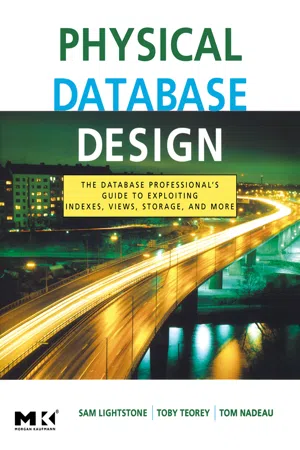
Physical Database Design
The Database Professional's Guide to Exploiting Indexes, Views, Storage, and More
- 448 pages
- English
- PDF
- Available on iOS & Android
Physical Database Design
The Database Professional's Guide to Exploiting Indexes, Views, Storage, and More
About this book
The rapidly increasing volume of information contained in relational databases places a strain on databases, performance, and maintainability: DBAs are under greater pressure than ever to optimize database structure for system performance and administration.Physical Database Design discusses the concept of how physical structures of databases affect performance, including specific examples, guidelines, and best and worst practices for a variety of DBMSs and configurations. Something as simple as improving the table index design has a profound impact on performance. Every form of relational database, such as Online Transaction Processing (OLTP), Enterprise Resource Management (ERP), Data Mining (DM), or Management Resource Planning (MRP), can be improved using the methods provided in the book.- The first complete treatment on physical database design, written by the authors of the seminal, Database Modeling and Design: Logical Design, Fourth Edition- Includes an introduction to the major concepts of physical database design as well as detailed examples, using methodologies and tools most popular for relational databases today: Oracle, DB2 (IBM), and SQL Server (Microsoft)- Focuses on physical database design for exploiting B+tree indexing, clustered indexes, multidimensional clustering (MDC), range partitioning, shared nothing partitioning, shared disk data placement, materialized views, bitmap indexes, automated design tools, and more!
Frequently asked questions
- Essential is ideal for learners and professionals who enjoy exploring a wide range of subjects. Access the Essential Library with 800,000+ trusted titles and best-sellers across business, personal growth, and the humanities. Includes unlimited reading time and Standard Read Aloud voice.
- Complete: Perfect for advanced learners and researchers needing full, unrestricted access. Unlock 1.4M+ books across hundreds of subjects, including academic and specialized titles. The Complete Plan also includes advanced features like Premium Read Aloud and Research Assistant.
Please note we cannot support devices running on iOS 13 and Android 7 or earlier. Learn more about using the app.
Information
Table of contents
- Front Cover
- Physical Database Design
- Copyright Page
- Contents
- Preface
- Chapter 1. Introduction to Physical Database Design
- Chapter 2. Basic Indexing Methods
- Chapter 3. Query Optimization and Plan Selection
- Chapter 4. Selecting Indexes
- Chapter 5. Selecting Materialized Views
- Chapter 6. Shared-nothing Partitioning
- Chapter 7. Range Partitioning
- Chapter 8. Multidimensional Clustering
- Chapter 9. The Interdependence Problem
- Chapter 10. Counting and Data Sampling in Physical Design Exploration
- Chapter 11. Query Execution Plans and Physical Design
- Chapter 12. Automated Physical Database Design
- Chapter 13. Down to the Metal: Server Resources and Topology
- Chapter 14. Physical Design for Decision Support, Warehousing, and OLAP
- Chapter 15. Denormalization
- Chapter 16. Distributed Data Allocation
- Appendix A. A Simple Performance Model for Databases
- Appendix B. Technical Comparison of DB2 HADR with Oracle Data Guard for Database Disaster Recovery
- Glossary
- Bibliography
- Index
- About the Authors